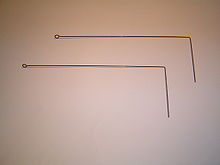Dowsing perfect- -Why ?
Dowsing is also known as divining (especially in reference to interpretation of results), doodlebugging (particularly in the United States, in searching for petroleum) or (when searching specifically for water) water finding, water witching (in the United States) or water dowsing.
A Y- or L-shaped twig or rod, called a dowsing rod, divining rod (Latin: virgula divina or baculus divinatorius), a "vining rod" or witching rod is sometimes used during dowsing, although some dowsers use other equipment or no equipment at all.
Dowsing appears to have arisen in the context of Renaissance magic in Germany, and it remains popular among believers in Forteana or radiesthesia
Dowsing as practiced today may have originated in Germany during the 15th century, when it was used in attempts to find metals. As early as 1518 Martin Luther listed dowsing for metals as an act that broke the first commandment (i.e., as occultism).[10] The 1550 edition of Sebastian Münster's Cosmographia contains a woodcut of a dowser with forked rod in hand walking over a cutaway image of a mining operation. The rod is labelled "Virgula Divina – Glück rüt" (Latin: divine rod; German "Wünschelrute": fortune rod or stick), but there is no text accompanying the woodcut. By 1556 Georgius Agricola's treatment of mining and smelting of ore, De Re Metallica, included a detailed description of dowsing for metal ore.[11] In the sixteenth century, German deep mining technology was in enormous demand all over Europe and German miners were licensed to live and work in Elizabethan England[12] particularly in the Stannaries of Devon & Cornwall and in Cumbria. It is thought that the dialect term "dowsing" was introduced at this period– its origin is unknown but features characteristics of the West Country dialects.
Although dowsing in search of water is considered an ancient practice by some, old texts about searching for water do not mention using the divining rod, and the first account of this practice was in 1568.[14] [15]
In 1662 dowsing was declared to be "superstitious, or rather satanic" by a Jesuit, Gaspar Schott, though he later noted that he wasn't sure that the devil was always responsible for the movement of the rod.[16] In the South of France in the 17th century it was used in tracking criminals and heretics. Its abuse led to a decree of the inquisition in 1701, forbidding its employment for purposes of justice.[17]
An epigram by Samuel Sheppard, from Epigrams theological, philosophical, and romantick (1651) runs thus:
- Virgula divina.
- "Some Sorcerers do boast they have a Rod,
- Gather'd with Vowes and Sacrifice,
- And (borne about) will strangely nod
- To hidden Treasure where it lies;
- Mankind is (sure) that Rod divine,
- For to the Wealthiest (ever) they incline."
Dowsing was conducted in South Dakota in the late 19th and early 20th centuries to help homesteaders, farmers, and ranchers locate water wells on their property.[18]
In the late 1960s during the Vietnam War, some United States Marines used dowsing to attempt to locate weapons and tunnels.[19] As late as in 1986, when 31 soldiers were taken by an avalanche during an operation in the NATO drill Anchor Express in Vassdalen, Norway, the Norwegian army attempted to locate soldiers buried in the avalanche using dowsing as a search method.[20]
Regardless of the scientific experiments, dowsing is still used by some farmers.
Equipment
Rods
Traditionally, the most common dowsing rod is a forked (Y-shaped) branch from a tree or bush. Some dowsers prefer branches from particular trees, and some prefer the branches to be freshly cut. Hazel twigs in Europe and witch-hazel in the United States are traditionally commonly chosen, as are branches from willow or peach trees. The two ends on the forked side are held one in each hand with the third (the stem of the Y) pointing straight ahead. Often the branches are grasped palms down.[citation needed] The dowser then walks slowly over the places where he suspects the target (for example, minerals or water) may be, and the dowsing rod dips, inclines or twitches when a discovery is made. This method is sometimes known as "willow witching".
Many dowsers today use a pair of simple L-shaped metal rods. One rod is held in each hand, with the short arm of the L held upright, and the long arm pointing forward. When something is found, the rods cross over one another making an X over the found object. If the object is long and straight, such as a water pipe, the rods may point in opposite directions, showing its orientation. The rods are sometimes fashioned from wire coat hangers, and glass or plastic rods have also been accepted. Straight rods are also sometimes used for the same purposes, and were not uncommon in early 19th-century New England.
In all cases, the device is in a state of unstable equilibrium from which slight movements may be amplified.[23]
Pendulum
A pendulum of crystal, metal or other materials suspended on a chain is sometimes used in divination and dowsing. In one approach the user first determines which direction (left-right, up-down) will indicate "yes" and which "no" before proceeding to ask the pendulum specific questions, or else another person may pose questions to the person holding the pendulum. The pendulum may also be used over a pad or cloth with "yes" and "no" written on it and perhaps other words written in a circle. The person holding the pendulum aims to hold it as steadily as possible over the center and its movements are held to indicate answers to the questions. In the practice of radiesthesia, a pendulum is used for medical diagnosis.
Feel free to consult us..
Consultant Astrologer
Dr. Suhas. R.
MCM, Ph.D.(Astro.Sci.)




No comments:
Post a Comment